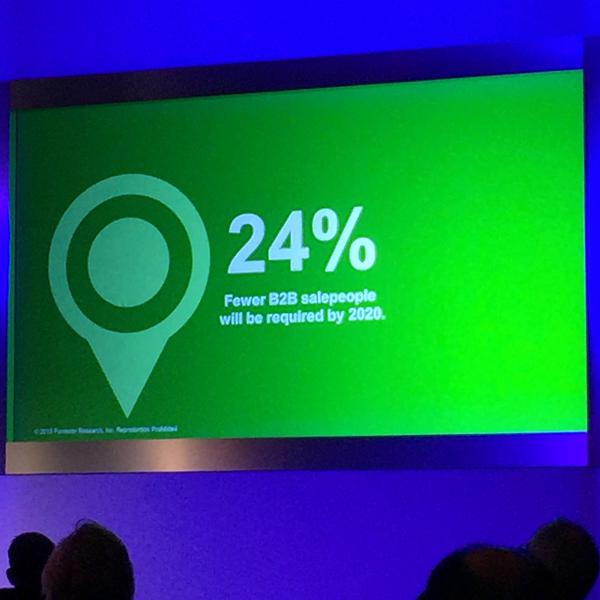This is what you missed at the Sales Enablement Forum
Wow! It may have taken place eight days ago, but I am still exhausted — and also exhilarated. In all modesty, we held a great Sales Enablement Forum in Scottsdale, Arizona last week. Nearly 350 attendees enjoyed presentations from 34 different speakers, including many industry practitioners, as well the opportunity to meet 21 sponsoring companies. For those of you who did not make it, here is a short recap of what we covered in the two days.
Day One: Challenge Thinking
Rowena Track from TE Connectivity kicked off our presentations on the main stage, discussing how to establish an infrastructure to help sales be successful. She focused on how customers were already well on their way to digital self-sufficiency, which means that the buyer’s journey starts well before your sales team is aware of them.
Forrester analyst Andy Hoar took the stage next and presented a wealth of data that revealed customers’ growing preference for engaging via self-serve eCommerce portals; this data led to him to predict that this will displace 1 million B2B salespeople over the next five years. Andy’s prediction and analysis resonated with attendees throughout the Forum.

Joanne Moretti from Jabil joined us next to talk about the evolution of sales enablement over the years, including her own experience creating HP’s Sales University, integrating Dell’s various software businesses, and in her current role at Jabil.
Neil Ringel, vice president of Staples Advantage, said that he enables his salespeople, his business partners, and his eBusiness site to help customers buy whenever, however, and wherever they want. EY’s Brian Goonon talked about the importance of trust and how customer loyalty is becoming the new metric of sales success in many companies.
Stephanie Meyer of GE Healthcare told us that she has banned "demand generation" from her department’s vocabulary. For her, the "lead" starts when the customer orders. It is all about creating sustainable engagement.
Forrester analysts led three breakout sessions:
- Lori Wizdo and Sheryl Pattek discussed how to research customers and the buyer journey; a panel discussion with four industry speakers followed.
- Mark Lindwall focused on training and developing salespeople; he also had guest speakers from the industry.
- Tim Harmon and his guests talked about changes in the channel: direct selling versus partner selling versus eBusiness selling.
Day Two: Lead Change
Day two began with three sold-out parallel working sessions:
- Lori and Sheryl were joined by Forrester consultants, who introduced tools to help incorporate buyer research into content messaging and sales conversations.
- In Mark’s working session, our research associate Jake Milender and Forrester sales reps participated in a role play to help attendees understand how to effectively leverage Forrester’s Salesperson Hiring Tool to identify the best sales candidates for their target buyers.
- In the third working session, Forrester researcher Fraser Tibbetts and I discussed how to develop and present a business case for sales enablement investments.
Then it was back to the keynote sessions. First, Forrester’s Laura Ramos talked about the importance of storytelling in creating customer engagement — both in marketing and in sales. Mindtree’s Paul Gottsegen then revealed his 6.5 keys to successful sales enablement, stating clearly that “Marketing = Sales Enablement.” And Doug Landis from Box talked about the importance of data in equipping salespeople for success, including how to install successful metrics to measure rep engagement and progress.
I brought all of this together by reminding attendees of the six business goals of sales enablement and pointing out that nobody really has full responsibility for all six: SE professionals wear six hats and must continually educate and influence their colleagues. As an immediate takeaway for all the attendees, I prescribed four sets of projects around Forrester's market imperatives that would help them achieve immediate impact on their return to the office.
A note: I opened the event by announcing our upcoming transition from the sales enablement role to the much more strategic B2B marketing role, scheduled to take effect on the Forrester website in April. Our sales enablement research will continue as planned within this new role, but it will be read by a much broader audience. And, after all, most SE professionals sit in marketing anyway. I will go into this change in more detail over the next few weeks.

Finally, I invited all attendees to put our next Forum on their calendars — in Miami in October 2016. While this Forum will be a bigger event and target the broader B2B marketing role, we will have at least one clear track focused on the sales enablement topics we discussed in Scottsdale. I look forward to seeing you there.
Always keeping you informed! Peter